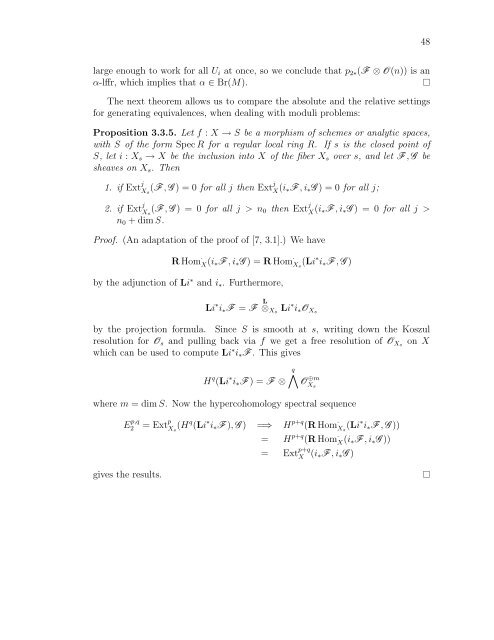derived categories of twisted sheaves on calabi-yau manifolds
derived categories of twisted sheaves on calabi-yau manifolds
derived categories of twisted sheaves on calabi-yau manifolds
Create successful ePaper yourself
Turn your PDF publications into a flip-book with our unique Google optimized e-Paper software.
large enough to work for all Ui at <strong>on</strong>ce, so we c<strong>on</strong>clude that p2∗(F ⊗ O(n)) is an<br />
α-lffr, which implies that α ∈ Br(M).<br />
The next theorem allows us to compare the absolute and the relative settings<br />
for generating equivalences, when dealing with moduli problems:<br />
Propositi<strong>on</strong> 3.3.5. Let f : X → S be a morphism <str<strong>on</strong>g>of</str<strong>on</strong>g> schemes or analytic spaces,<br />
with S <str<strong>on</strong>g>of</str<strong>on</strong>g> the form Spec R for a regular local ring R. If s is the closed point <str<strong>on</strong>g>of</str<strong>on</strong>g><br />
S, let i : Xs → X be the inclusi<strong>on</strong> into X <str<strong>on</strong>g>of</str<strong>on</strong>g> the fiber Xs over s, and let F , G be<br />
<str<strong>on</strong>g>sheaves</str<strong>on</strong>g> <strong>on</strong> Xs. Then<br />
1. if Ext j<br />
(F , G ) = 0 for all j then Extj<br />
Xs X (i∗F , i∗G ) = 0 for all j;<br />
2. if Ext j<br />
Xs (F , G ) = 0 for all j > n0 then Ext j<br />
X (i∗F , i∗G ) = 0 for all j ><br />
n0 + dim S.<br />
Pro<str<strong>on</strong>g>of</str<strong>on</strong>g>. (An adaptati<strong>on</strong> <str<strong>on</strong>g>of</str<strong>on</strong>g> the pro<str<strong>on</strong>g>of</str<strong>on</strong>g> <str<strong>on</strong>g>of</str<strong>on</strong>g> [7, 3.1].) We have<br />
R Hom ·<br />
X(i∗F , i∗G ) = R Hom ·<br />
Xs (Li∗ i∗F , G )<br />
by the adjuncti<strong>on</strong> <str<strong>on</strong>g>of</str<strong>on</strong>g> Li ∗ and i∗. Furthermore,<br />
Li ∗ i∗F = F L<br />
⊗Xs Li ∗ i∗OXs<br />
by the projecti<strong>on</strong> formula. Since S is smooth at s, writing down the Koszul<br />
resoluti<strong>on</strong> for Os and pulling back via f we get a free resoluti<strong>on</strong> <str<strong>on</strong>g>of</str<strong>on</strong>g> OXs <strong>on</strong> X<br />
which can be used to compute Li ∗ i∗F . This gives<br />
H q (Li ∗ i∗F ) = F ⊗<br />
q O ⊕m<br />
where m = dim S. Now the hypercohomology spectral sequence<br />
E p,q<br />
2 = Ext p<br />
Xs (Hq (Li ∗ i∗F ), G ) =⇒ H p+q (R Hom ·<br />
Xs (Li∗ i∗F , G ))<br />
= H p+q (R Hom ·<br />
X(i∗F , i∗G ))<br />
= Ext p+q<br />
X (i∗F , i∗G )<br />
gives the results.<br />
Xs<br />
48
















